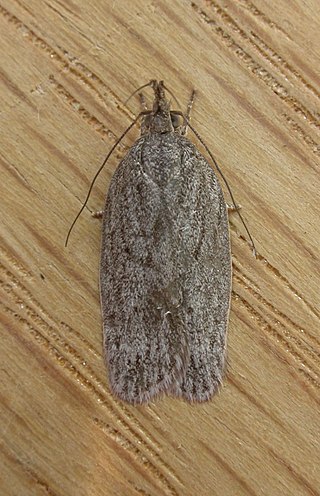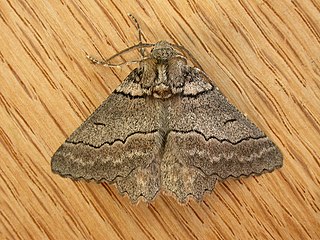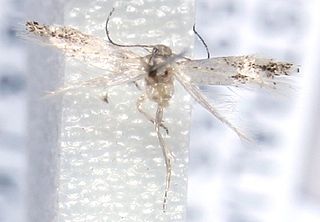
The grey currawong is a large passerine bird native to southern Australia, including Tasmania. One of three currawong species in the genus Strepera, it is closely related to the butcherbirds and Australian magpie of the family Artamidae. It is a large crow-like bird, around 48 cm (19 in) long on average; with yellow irises, a heavy bill, dark plumage with white undertail and wing patches. The male and female are similar in appearance. Six subspecies are recognised and are distinguished by overall plumage colour, which ranges from slate-grey for the nominate from New South Wales and eastern Victoria and subspecies plumbea from Western Australia, to sooty black for the clinking currawong of Tasmania and subspecies halmaturina from Kangaroo Island. All grey currawongs have a loud distinctive ringing or clinking call.

The western grey kangaroo, also referred to as a western grey giant kangaroo, black-faced kangaroo, mallee kangaroo, sooty kangaroo and Kangaroo Island grey kangaroo, is a large and very common kangaroo found across almost the entire southern part of Australia, from just south of Shark Bay through coastal Western Australia and South Australia, into western Victoria, and in the entire Murray–Darling basin in New South Wales and Queensland.

The white-faced heron also known as the white-fronted heron, and incorrectly as the grey heron, or blue crane, is a common bird throughout most of Australasia, including New Guinea, the islands of Torres Strait, Indonesia, New Zealand, and all but the driest areas of Australia.

The galah, less commonly known as the pink and grey cockatoo or rose-breasted cockatoo, is an Australian species of cockatoo and the only member of the genus Eolophus. The galah is adapted to a wide variety of modified and unmodified habitats and is one of Australia's most abundant and widespread bird species. The species is endemic to mainland Australia. It was introduced to Tasmania, where it is now widespread, in the mid-19th century and much more recently to New Zealand.

The eastern rosella is a rosella native to southeastern Australia, including Tasmania.

The Pacific black duck, commonly known as the PBD, is a dabbling duck found in much of Indonesia, New Guinea, Australia, New Zealand, and many islands in the southwestern Pacific, reaching to the Caroline Islands in the north and French Polynesia in the east. It is usually called the grey duck in New Zealand, where it is also known by its Maori name, pārera.

The brown falcon is a relatively large falcon native to Australia and New Guinea.

The scarlet robin is a common red-breasted Australasian robin in the passerine bird genus Petroica. The species is found on continental Australia and its offshore islands, including Tasmania. The species was originally split in 1999 by Schodde and Mason, and as the original collection by Gmelin was from Norfolk Island, this retained the name of multicolor, and is now known as the Norfolk robin.

The olive whistler or olivaceous whistler, is a species of bird in the family Pachycephalidae, the whistlers, that is native to southeastern Australia.

The blue-winged parrot, also known as the blue-banded parakeet or blue-banded grass-parakeet, is a small parrot found in Tasmania and southeast mainland Australia. It is partly migratory, with populations of blue-winged parrots travelling to Tasmania for the summer. The parrot is sexually dimorphic – the males have more blue on the wings and a two-toned blue frontal band on the head, while females are duller and have more green on the wings and a wingbar. Both sexes have predominantly olive-green plumage. Predominantly a feeder on the ground, the blue-winged parrot mainly eats seeds of grasses. It adapts readily to captivity.

Masked woodswallow is a species of bird in the family Artamidae.

The dusky robin is a small passerine bird native to Tasmania. A member of the Australian robin family Petroicidae, it is known by many other names such as Dozey, Sad, Sleepy, Stump, Tasmania/Wood Robin; Native Sparrow or Sad Bird.

Pedois lewinella is a species of moth of the family Depressariidae. It is found in Australia, where it has been recorded from southern Queensland, New South Wales, the Australian Capital Territory, Victoria, Tasmania, South Australia and Western Australia.

The silky hairstreak or chlorinda hairstreak is a butterfly belonging to the family Lycaenidae. The species was first described by Emile Blanchard in 1848. It occurs in Australia. It is the only species in the monotypic genus Pseudalmenus, described by Hamilton Herbert Druce in 1902.
Batrachedra helarcha is a species of moth of the family Batrachedridae. It is found in Australia.
Tasmantrix tasmaniensis is a moth of the family Micropterigidae. It is known from in wet forests of western Tasmania.

Hypobapta percomptaria, the southern grey, is a moth of the family Geometridae first described by Achille Guenée in 1857. It is known from Australia, including South Australia, New South Wales, Queensland, Victoria and Tasmania.

Elachista zophosema is a moth of the family Elachistidae that is found in Australia, where it has been recorded from higher altitudes in Tasmania.
Pingasa cinerea, the tan-spotted grey, is a moth of the family Geometridae. The species was first described by William Warren in 1894. It is found in the Australian states of New South Wales, Queensland, Tasmania and Victoria.

The grey skate is a species of fish in the family Rajidae. It was described in 2008 by Australian ichthyologist Peter R. Last.
















